Soviet Air Forces
| Военно-воздушные силы СССР Voyenno-vozdushnye sily SSS ui | |
|---|---|
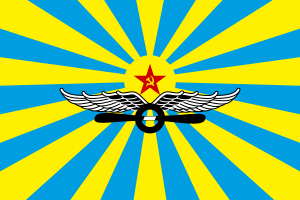 Flag of the Soviet Air Force | |
| Active | 24 May 1918 – 26 December 1991 |
| Country |
|
| Size |
10,100 aircraft (1973) 7,859 aircraft (1990) |
| Main Staff | Moscow |
| Insignia | |
| Roundel |
 |
| Aircraft flown | |
| Attack | Su-22, Su-24, Su-25, MiG-27 |
| Bomber | Tu-16, Tu-22, Tu-95, Tu-160 |
| Fighter | MiG-21, MiG-23, MiG-25, MiG-29, Su-27 |
| Helicopter | Mi-2, Mi-8, Mi-17, Mi-14 |
| Attack helicopter | Mi-24 |
| Transport | Il-76, An-12, An-22, An-124 |
The Soviet Air Forces (Russian: Военно-воздушные силы, tr. Voyenno-Vozdushnye Sily (VVS), literally "Military Air Forces") was the official designation of one of the air forces of the Soviet Union. The other was the Soviet Air Defence Forces. The Air Forces were formed from components of the Imperial Russian Air Service in 1917, and faced their greatest test during World War II. The groups were also involved in the Korean War, and dissolved along with the Soviet Union itself in 1991–92. Former Soviet Air Forces' assets were subsequently divided into several air forces of former Soviet republics, including the new Russian Air Force. "March of the Pilots" was its anthem.
Origins
The All-Russia Collegium for Direction of the Air Forces of the Old Army (translation is uncertain) was formed on 20 December 1917. This was a Bolshevik aerial headquarters initially led by Konstantin Akashev. Along with a general postwar military reorganisation, the collegium was reconstituted as the "Workers' and Peasants' Red Air Fleet" (Glavvozduhflot), established on 24 May 1918 and given the top-level departmental status of "Main Directorate".[1][2]
It became the Directorate of the USSR Air Forces on 28 March 1924, and then the Directorate of the Workers-Peasants Red Army Air Forces on 1 January 1925. Gradually its influence on aircraft design became greater. From its earliest days, the force mimicked ground forces' organization especially in the 1930s, by which time it was made up of air armies, aviation corps, aviation divisions, and aviation regiments (composed of air squadrons, flights, and fireteams, respectively).
| Soviet Armed Forces |
|---|
 |
| Components |
| Ranks of the Soviet Military |
| History of the Soviet Military |
After the creation of the Soviet state many efforts were made in order to modernize and expand aircraft production, led by its charismatic and energetic commander, General Yakov Alksnis, an eventual victim of Joseph Stalin's Great Purge.[3] Domestic aircraft production increased significantly in the early 1930s and towards the end of the decade, the Soviet Air Force was able to introduce Polikarpov I-15 and I-16 fighters and Tupolev SB and SB-bis and DB-3 bombers.[4]
| Air Forces of Russia |
|---|
|
Air Force (1909–1917) Red Air Force (1918–1991) Naval Aviation (1918–1991) Air Defence (1948–1991) Strategic Rocket Forces (1959–1991) Air Force (1991–present) Naval Aviation (1991–present) Strategic Rocket Forces (1991–present) |
Spanish civil war
One of the first major tests for the VVS came in 1936 with the Spanish Civil War, in which the latest Soviet and German aircraft designs were employed against each other in fierce air-to-air combat. At first, the I-16 proved superior to any Luftwaffe fighters, and managed to achieve local air superiority wherever they were employed. However, the Soviets refused to supply the plane in adequate numbers, and their aerial victories were soon squandered because of their limited use. Later, Bf-109s delivered to Franco's Spanish Nationalist air forces secured air superiority for the Nationalists, one they would never relinquish. The defeats in Spain coincided with the arrival of Stalin's Great Purge of the ranks of the officer corps and senior military leadership, which severely affected the combat capabilities of the rapidly expanding Soviet Air Forces. Newly promoted officers lacked flying and command experience, while older commanders, witnessing the fate of General Alksnis and others, lacked initiative, frequently referring minor decisions to Moscow for approval, and insisting that their pilots strictly comply with standardized and predictable procedures for both aerial attack and defence.
On 19 November 1939, VVS headquarters was again titled the Main Directorate of the Red Army Air Forces under the WPRA HQ.
1930s aviation and propaganda
Between 1933 and 1938, the Soviet government planned and funded missions to break numerous world aviation records. Not only did aviation records and achievements become demonstrations of the USSR's technological progress, they also served as legitimization of the socialist system. With each new success, Soviet press trumpeted victories for socialism, popularizing the mythology of aviation culture with the masses. Furthermore, Soviet media idolized record-breaking pilots, exalting them not only as role models for Soviet society, but also as symbols of progress towards the socialist-utopian future.
Positive heroism
The early 1930s saw a shift in ideological focus away from collectivist propaganda and towards "positive heroism."[5] Instead of glorifying socialist collectivism as a means of societal advancement, the Soviet Communist Party began uplifting individuals who committed heroic actions that advanced the cause of socialism.[6] In the case of aviation, the government began glorifying people who utilized aviation technology instead of glorifying the technology itself. Pilots such as Valery Chkalov, Georgy Baydukov, Alexander Belyakov, and Mikhail Gromov—as well as many others—were raised to the status of heroes for their piloting skills and achievements.
Transpolar flights of 1937
In May 1937, Stalin charged pilots Chkalov, Baydukov, and Belyakov with the mission to navigate the first transpolar flight in history.[7] On 20 June 1937, the aviators landed their ANT-25 in Vancouver, Washington. A month later, Stalin ordered the departure of a second crew to push the boundaries of modern aviation technology even further. In July 1937 Mikhail Gromov, along with his crew Sergei Danilin and Andrei Yumashev, completed the same journey over the North Pole and continuing on to Southern California, creating a new record for the longest nonstop flight.[8]
The public reaction to the transpolar flights was euphoric. The media called the pilots "Bolshevik knights of culture and progress."[9] Soviet citizens celebrated Aviation Day on 18 August with as much zeal as they celebrated the October Revolution anniversary.[10] Literature including poems, short stories, and novels emerged celebrating the feats of the aviator-celebrities.[11] Feature films like Victory, Tales of Heroic Aviators, and Valery Chkalov reinforced the "positive hero" imagery, celebrating the aviators' individuality within the context of a socialist government.[8][12]
Folkloric themes in aviation propaganda
Soviet propaganda, newspaper articles, and other forms of media sought to connect Soviet citizens to relevant themes from daily life. For aviation, Stalin's propagandists drew on Russian folklore. Examples increased dramatically following the successes of the transpolar flights by Chkalov and Gromov in 1937. Aviators were referred to symbolically as sokoly (falcons), orly (eagles),[13] or bogatyry (warriors).[14] Newspapers told traditional Russian narratives (skazki) of fliers conquering time and space (prostranstvo), overcoming barriers and completing their missions in triumph.[15] Even the story of each aviator suggests roots in old Russian storytelling and narratives—virtuous heroes striving to reach an end goal, encountering and conquering any obstacles in their path. By using folklore rhetoric, Stalin and Soviet propagandists connected aviation achievements to Russian heritage, making aviation seem more accessible to the Soviet population. Furthermore, the narratives emphasize the aviators' selflessness and devotion to a higher socialist ideal, pointing to Soviet leaders as inspirers and role models.[15]
Paternalism was also a theme that Soviet propagandists exploited in aviation culture. The media presented Stalin as an example and inspiration, a father figure and role model to the most prominent Soviet pilots of the period.[16] When recounting stories of meetings between Stalin and Chkalov, for example, Soviet newspapers spoke of Stalin's paternalism towards the young pilot. The paternal metaphor was completed with the addition of a maternal figure—Russia, the motherland, who had produced "father" Stalin's heroic sons such as Chkalov.[15]
The use of familial metaphors not only evoked traditional hereditary pride and historic Russian patriotism, they boosted Stalin's image as a benevolent leader. Most importantly, paternalism served to promote the message of individual subordination to authority.[17] Through his paternal relationships with Soviet pilots, Stalin developed an "ethos of deference and obedience"[16] for Soviet society to emulate.
Aviation and the purges
The successful achievements in Soviet aviation also came during the worst days of the Great Purge. The transpolar flights in summer 1937 occurred following the arrest and execution of a large body of the Red Army officer corps.[18] Fifteen of sixteen total army commanders were executed; more than three-fourths of the VVS senior officers were arrested, executed, or relieved of duty.[19] News coverage of the arrests was relatively little compared to treatment of aviation exploits, deflecting attention away from the arrests.[20]
Early combat
Some practical combat experience had been gained in participating in the Spanish Civil War, and against Japan in the Far East. Shortly before the start of war with Germany a Soviet Volunteer Group was sent to China to train the pilots from the Republic of China Air Force for the continuing war with the Japanese. However, these experiences proved of little use in the Winter War against Finland in 1939, where scores of inexperienced Soviet bomber and fighter pilots were shot down by a relatively small number of Finnish Air Force (FAF) pilots. The VVS soon learned established Soviet air defence procedures derived from the Spanish Civil War, such as forming defensive circles when attacked, did not work well against the Finns, who employed dive-and-zoom tactics to shoot down their Soviet opponents in great numbers. The effects of the Great Purge undoubtedly played a role in the slow reaction of the VVS and its command to the new realities of air combat. The Soviet Air Force as well as the Soviet aircraft industry would eventually learn from these combat experiences, though not before the German invasion of the Soviet Union in 1941.
On 1 January 1941, six months prior to Operation Barbarossa, the Air Forces of the Soviet Red Army had 363,900 serving personnel, accounting for 8.65% of all military force personnel of the Soviet Union.[21]
The first three Air Armies, designated Air Armies of Special Purpose, were created between 1936 and 1938.[22] On 5 November 1940 these were reformed as the Long Range Bombardment Aviation of the High Command of the Red Army (until February 1942) due to lack of combat performance during the conflict with Finland.[23]
The Air Force was hit hard by the Red Army purges in 1941.
Early World War II aviation failures
1930s Soviet aviation also had a particular impact on the USSR's military failures in the beginning of World War II. By 1938, the Soviet Union had the largest air force in the world, but Soviet aeronautical design distinctly lagged behind Western technological advances.[24] Instead of focusing on developing tactical aircraft, the Soviets engineers developed heavy bomber planes only good for long distance—in other words, planes that would be used for record-breaking flights like those of Chkalov's.[25] The Soviet government's focus on showy stunts and phenomenal record-breaking missions drained resources needed for Soviet defense. When Nazi Germany attacked the Soviet Union in June 1941, it quickly became apparent that the Soviet Air Force was not prepared for war.[26] Poor planning and lack of organization left planes sitting on the tarmac at airbases, allowing the Luftwaffe to destroy 4,000 Soviet planes within the first week.[27] The disorganized Soviet defenses and technologically deficient aircraft were no match for the Luftwaffe.
World War II
At the outbreak of World War II, the Soviet military was not yet at a level of readiness suitable for winning a war: Joseph Stalin had said in 1931 Soviet industry was "50 to 100 years behind"[28] the Western powers. By the end of the war, Soviet annual aircraft production had risen sharply, reaching 40,241 in 1944. Some 157,261 machines were produced during the Great Patriotic War, 125,655 being of combat types.[29]
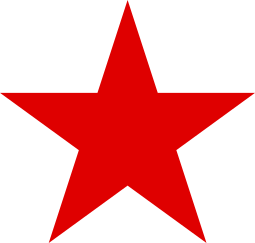
The main reason for the large aircraft losses in the initial period of war with Germany was not the lack of modern tactics, but the lack of experienced pilots and ground support crews, the destruction of many aircraft on the runways due to command failure to disperse them, and the rapid advance of Heer troops, forcing the Soviet pilots on the defensive during Operation Barbarossa, while being confronted with more modern German designs.[30] In the first few days of the invasion of the Soviet Union, the Luftwaffe destroyed some 2,000 Soviet aircraft, most on the ground, at a loss of only 35 (of which 15 were non-combat-related).[31]
The principal VVS aircraft during World War II were the Ilyushin Il-2 Shturmovik armored ground attack monoplane and the series of AS Yakovlev OKB-115 designed single-engined fighters, beginning with the Yak-1 and its successors.[30] The Il-2 became (at 36,183 built) the most produced military aircraft of all time, with the four main versions of Yak fighters (the Yak-1, −3, −7 and −9) being slightly more numerous, at a total of 36,716 among them. These two main types together accounted for about half the strength of the VVS for most of the Great Patriotic War. The Yak-1 was a modern 1940 design and had room for development, unlike the mature 1935-origin Messerschmitt Bf 109. The Yak-9 brought the VVS to parity with the Luftwaffe and eventually allowed it to gain the upper hand, until in 1944, many Luftwaffe pilots deliberately avoided combat with the last and best variant, the out-of-sequence numbered Yak-3. The other main VVS types were Lavochkin fighters (mainly the La-5), the Petlyakov Pe-2 twin engined attack-bombers, and a basic but functional and versatile medium bomber, the Ilyushin Il-4.
The 31st Bomber Aviation Regiment, equipped with Pe-2s and commanded by Colonel Fyodor Ivanovich Dobysh, was one of the first Guards bomber units in the Air Forces – the 4th Guards Bomber Aviation Regiment (ru:4-й гвардейский пикирующий бомбардировочный авиационный полк).[32] The title was conferred on the regiment for its actions on the Leningrad Front in November–December 1941 during defensive operations and the Soviet counterattack near Tikhvin.
Women
Alone among World War II combatants, the Soviet Air Force initiated a program to bring women with existing flying training into combat air groups. Marina Raskova, one of very few women in the VVS prior to the war, used her influence with Stalin to form three all-female air regiments: the 586th Fighter Aviation Regiment, the 587th Bomber Aviation Regiment, and the 588th Night Bomber Aviation Regiment (a.k.a. the Night Witches.) Women flew aircraft so heavy that sometimes two of them were required to haul back on the joystick on takeoff. Another pilot, Olga Yemshokaya, flying at ten thousand feet, discovered a mouse, put there by mischievous male colleagues, in her cockpit. Being more worried by the rodent than the German fighter threat, she hunted for, eventually caught and ejected it.[33]
Due to their achievements in battle, the latter two air force units were honored by being renamed Guards units. Beyond the three official regiments, individual Soviet women sometimes served alongside airmen in otherwise all-male groups.[34] Women pilots, navigators, gunners, mechanics, armament specialists and other female ground personnel made up more than 3,000 fighting members of the VVS. Women pilots flew 24,000 sorties. From this effort came the world's only two female fighter aces: Lydia Litvyak and Katya Budanova.
Innovation and Lend-lease
While there were scores of Red Army divisions on the ground formed from specific Soviet republics, there appears to have been very few aviation regiments formed from nationalities, among them being the 1st Latvian Night Aviation Regiment.[35]
Chief Marshal of Aviation Alexander Novikov led the VVS from 1942 to the end of the war, and was credited with introducing several innovations and weapons systems. For the last year of the war German military and civilians retreating towards Berlin were hounded by the presence of "low flying aircraft" strafing and bombing them, an activity in which even the ancient Polikarpov Po-2, a much produced biplane of 1920s design, took part. However, this was but a small measure of the experience the Wehrmacht were receiving due to the sophistication and superiority of the Red Air Force. In one strategic operation alone, the Yassy-Kishinev Strategic Offensive, the 5th and 17th Air Armys and the Black Sea Fleet Naval Aviation aircraft achieved a 3.3 to 1 superiority in aircraft over Luftflotte 4 and the Royal Romanian Air Force, allowing almost complete freedom from air harassment for the ground troops of the 2nd and 3rd Ukrainian Fronts.[36]
As with many Allied countries in World War II, the Soviet Union received Western aircraft through Lend-Lease, mostly Bell P-39 Airacobras, Bell P-63 Kingcobras, Hawker Hurricanes, Curtiss P-40 Kittyhawks and Douglas A-20 Havocs. Some of these aircraft arrived in the Soviet Union in time to participate in the Battle of Moscow, and in particular with the PVO or Soviet Air Defence Forces.[37] Soviet fliers in P-39s scored the highest individual kill totals of any ever to fly a U.S. aircraft. Two air regiments were equipped with Spitfire Mk.Vbs in early 1943 but immediately experienced unrelenting losses due to friendly fire as the British aircraft looked too much like the German Bf 109.[38] Lend-Lease aircraft from the U.S. and UK accounted for nearly 12% of total Soviet air power.[39]
The greatest Soviet fighter ace of World War II was Ivan Nikitovich Kozhedub, who scored 62 victories from 6 July 1943 to 16 April 1945,[40] the top score for any Allied fighter pilot of World War II.
Cold War
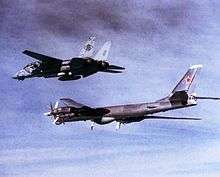
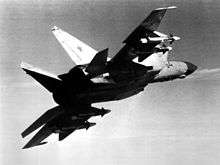
In 1945–46, the WPKA Army Air Forces became the Soviet Air Forces once again. Its capabilities increased. The force became one of the best services of the Soviet Armed Forces due to the various types of aircraft being flown and their capabilities and the strength and training of its pilots, and its air defense arm became an independent component of the armed forces in 1949, reaching full-fledged force status in 1954.
The 64th Fighter Aviation Corps (ru:64-й истребительный авиационный корпус) fought in the Korean War.
During the Cold War, the Soviet Air Force was rearmed, strengthened and modern air doctrines were introduced. At its peak in 1980, it could deploy approximately 10,000 aircraft, making it the world's largest air force of the time.[41]
In 1977 the VVS and the Soviet Air Defense Forces were re-organised in the Baltic states and the Leningrad Oblast, as a trial run for the larger re-organisation in 1980 covering the whole country.[42] All fighter units in the PVO were transferred to the VVS, the Air Defence Forces only retaining the anti-aircraft missile units and radar units. The 6th independent Air Defense Army was disbanded, and the 15th Air Army became the VVS Baltic Military District.
Though the experiment was then applied countrywide in 1980, it was reversed in 1986, but then most of the Air Defense Forces's command and control duties and assets became part of the Air Force, as well as several educational and training institutions.
According to a 1980 Time Magazine article citing analysts from RAND Corporation, allegedly Soviet non-Slavs, including Jews, Armenians, and Asians were generally barred from senior ranks and from joining elite or strategic positions in the Air Force, Strategic Rocket Forces, and the Soviet Navy because of doubts regarding the loyalty of ethnic minorities. RAND analyst S. Enders Wimbush said, "Soldiers are clearly recruited in a way that reflects the worries of society. The average Russian citizen and Soviet decision maker have questions about the allegiance of the non-Slav, especially the Central Asian."[43][44][45][46][47]
During the Cold War the VVS was divided into three main branches (equivalent to commands in Western air forces): Long Range Aviation (Dal'naya Aviatsiya - DA ), focused on long-range bombers; Frontal Aviation (Frontovaya Aviatsiya - FA), focused on battlefield air defence, close air support, and interdiction; and Military Transport Aviation (Voenno-Transportnaya Aviatsiya - VTA), which controlled all transport aircraft. The Soviet Air Defence Forces (Voyska protivovozdushnoy oborony or Voyska PVO), which focused on air defence and interceptor aircraft, was then a separate and distinct service within the Soviet military organisation.
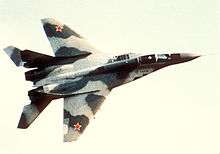
Yet another independent service was the Soviet Navy's air arm, the Soviet Naval Aviation (Aviatsiya Voenno Morskogo Flota - "AV-MF"), under the Navy Headquarters.
The official day of VVS was the Soviet Air Fleet Day, that often featured notable air shows meant to display Soviet air power advancements through the years, held in Moscow's Tushino airfield.
1980s fighter programs
In the 1980s the Soviet Union acknowledged the development of the Advanced Tactical Fighter in the USA and began the development of an equivalent fighter.
Two programs were initiated, one of which was proposed to directly confront the United States' then-projected Advanced Tactical Fighter (that was to lead to the development of the F-22 Raptor and the YF-23 Black Widow II). This future fighter was designated as Mnogofounksionalni Frontovoi Istrebitel (MFI) (Multifunctional Frontline Fighter) and designed as a heavy multirole aircraft, with air-supremacy utmost in the minds of the designers.
In response to the American X-32/F-35 project, Russia began the LFI program, which would develop a fighter reminiscent of the X-32/F-35 with a single engine, without the capabilities of a true multirole aircraft. The LFI (Lyogkiy Frontovoy Istrebitel, Light Frontline Fighter) project was intended to develop a lightweight fighter with respectable air-to-ground capabilities. Yakovlev proposed the Yak-43, an upgraded Yak-41 with a stealthier design and more powerful engines. After neglecting the MFI competition, Sukhoi decided to submit a design for the LFI called the S-37 (unrelated to the heavyweight forward-swept wing fighter). This S-37 resembled the Gripen in that it had canard foreplanes, a delta wing and one engine. Mikoyan entered the MiG 4.12. MiG could not afford to develop both the MFI and LFI, so their LFI entry was eventually withdrawn. Developed into Mikoyan LMFS.
Russia would later change the designation of the LFI project to LFS, making it a multirole aircraft with emphasis on ground attack capability. During the 1990s the Russian military cancelled the LFS projects and continued with the MFI project, with minimal funding, believing that it was more important than the production of a light fighter aircraft. No advanced fighter successor to the Su-27 and MiG-29 family has entered service. Sukhoi won the latest PAK FA competition in 2002; the aircraft's first flight took place on 29 January 2010.[48][49]
Breakup of the Soviet Union
Following the collapse of the Soviet Union in December 1991 the aircraft and personnel of the Soviet VVS were divided among the newly independent states. Russia received the plurality of these forces, approximately 40% of the aircraft and 65% of the manpower, with these forming the basis for the new Russian Air Force.
Forces in the late 1980s


Long range aviation
- 30th Air Army VGK (Irkutsk, Long Range Aviation)
- 37th Air Army VGK (Special subordination; Moscow, Long Range Aviation)
- 46th Air Army VGK (Smolensk, Long Range Aviation)
Frontal Aviation
- 16th Air Army (Group of Soviet Forces in Germany)
- 4th Air Army VGK (Special purpose)
- 36th Air Army (Southern Group of Forces, Hungary)
- 131st Mixed Aviation Division (Central Group of Forces), Milovice, Czechoslovakia
Military transport aviation
Military Transport Aviation included six separate regiments, and five divisions with a total of 18 military transport aviation regiments in 1988. The divisions were the 3rd Guards Military Transport Aviation Division (VTAD) at Vitebsk (four regiments), the 6th Military Transport Aviation Division at Krivoy Rog (two regiments), the 8th Division at Omsk Chkalovsk near Omsk (three OSNAZ regiments), the 12th Military Transport Aviation Division at Migalovo, which traced its heritage to the 12th Bomber Aviation Division of the World War II period, and had three regiments, and the 18th Military Transport Aviation Division at Shaulyai, tracing its history to the wartime 6th Guards Bomber Aviation Division, and had three regiments. (Feskov et al. 2004, p. 146)
Frontal aviation
- 5th Air Army (Frontal Aviation) (Odessa Military District)
- 15th Air Army (Baltic Military District)
- 26th Air Army (Belarussian Military District) On 15 June 1992, by decree No. 05 of the Ministry of Defence of the Republic of Belarus, the 26th Air Army headquarters became the command of the Air Forces of the Republic of Belarus.
- 14th Air Army (Carpathian Military District)
- 24th Air Army VGK (Special purpose) (South-Western Strategic Direction) At the dissolution of the Soviet Union this Army had forces in Belarus and Ukraine. In Ukraine forces consisted of the 32nd Bomber Aviation Division, at Starokonstantinov, the 56th Bomber Aviation Division at Cherlyany, and the 138th Fighter Aviation Division at Mirgorod. In Ukraine in 1991–92, this Army had available over 140 Su-24 Fencer, over 35 Yak-28 electronic warfare aircraft, and 40 MiG-27 Floggers and 40 Su-27 Flankers for strike escort.[50]
- 34th Air Army (Transcaucasian Military District)
- 73rd Air Army (Tashkent, Turkestan Military District)
- 76th Air Army (Leningrad, Leningrad Military District)
- VVS Moscow Military District
- 23rd Air Army (Transbaikal Military District)
- 1st Air Army of Frontal Aviation (Far Eastern Military District)
- VVS Of Volga-Urals Military District
In addition, the 34th Mixed Aviation Corps (ru:34-й смешанный авиационный корпус) supported the 40th Army in Afghanistan during the Soviet–Afghan War.
Soviet Air Defence Forces
Independent air defense component of the Soviet Armed Forces under Headquarters, Voyska PVO (Soviet Air Defence Forces).
- 2nd Air Defence Army (Soviet Air Defence Forces) (part)
- 4th Independent Air Defence Army
- 6th Independent Air Defence Army (Soviet Air Defence Forces)
- 8th Independent Air Defence Army (Soviet Air Defence Force)
- 10th Independent Air Defence Army (Soviet Air Defence Forces)
- 11th Independent Air Defence Army (Far East Military District)
- 12th Independent Air Defence Army (Soviet Air Defence Forces)
- 14th Independent Air Defence Army (Soviet Air Defence Forces)
- 19th Air Defence Army
Training schools of the VVS and PVO
A Krasnaya Zvezda military schools list of 17 January 1980 included 24 Air Forces schools.[51] Nine Higher Aviation Schools of Pilots were reported (including the Borisoglebsk Higher Military Aviation School of Pilots at Borisoglebsk), two navigator schools (including the Chelyabinsk Higher Military Aviation School of Navigators/50th Anniversary of the Komsomols), the Khar'kov Higher Military Aviation Command School of Signals, five three-year technical secondary schools, six Air Force engineering schools (including the Kiev Higher Military Aviation Engineering School), and the Kurgan Higher Military-Political Aviation School.
In 1988, schools included:[52]
- 5th Central Course for Preparation and Improvement of Aviation Personnel, Frunze, Chui Oblast, Kyrgyz SSR (HQ VVS)
- 796th Red Banner Center for Preparation of Officers for Fighter and Fighter-Bomber Aviation, Totskoye, Orenburg Oblast (HQ VVS)
- Armavir Higher Military Aviation School of Pilots PVO (Air Forces of the North Caucasus Military District)
- Balashov Higher Military Aviation School of Pilots (Air Forces of the Volga-Ural Military District)
- Barnaul Higher Military Aviation School of Pilots (Air Forces of the Siberian Military District)
- Borisoglebsk Higher Military Aviation School of Pilots (Borisoglebsk, VVS NCMD)
- Chelyabinsk Higher Military Aviation School of Navigators
- Kacha Higher Military Aviation School of Pilots (Volgograd, HQ VVS)(ru:Качинское высшее военное авиационное училище лётчиков)
- Kansk Military Aviation School of Air Rifle-Radio Operators VVS (Kansk, VVS Siberian Military District)
- Krasnodar Higher United Flight-Technical School (Krasnodar, VVS NCMD; ru:Краснодарское высшее военное авиационное училище лётчиков)
- Orenburg Higher Military Aviation School of Pilots (Orenburg, VVS Volga-Ural Military District)
- Saratov Higher Military Aviation School of Pilots (Saratov, VVS Volga-Urals Military District; helicopter training)
- Stavropol Higher Military Aviation School of Pilots and Navigators PVO (Stavropol, VVS North Caucasus Military District)
- Syzran Higher Military Aviation School of Pilots
- Tambov Higher Military Aviation School of Pilots (Tambov, Tambov Oblast, Air Forces of the Moscow Military District)
- Ufa Higher Military Aviation School of Pilots (Ufa)
- Yeysk Higher Military Aviation School (Yeysk, ru:Ейский высший военный авиационный институт)
- 17th Air Army (Kiev Military District, primarily a training force)
- Chernigov Higher Military Aviation School of Pilots (Chernigov, VVS Kiev Military District)
- Kharkov Higher Military Aviation School of Pilots (Kharkov-Chuguyev, VVS Kiev Military District)
- Voroshilovgrad Higher Military Aviation School of Navigators (Lugansk)
There is also a list of Soviet Air Force bases listing the various air bases of the force.
"March of the Pilots"
"March of the Pilots" was the official anthem of the Air Forces of the USSR. It was written and published in the spring of 1923. Music by Yuliya Abramovich Hite, lyrics by Paul Davidovich Herman.
Commanders-in-Chief
- Konstantin Akashev (December 1917 - May 1918)
- Mikhail Solovov (May 1918 — July 1918)
- Alexander Vorotnikov (August 1918 — July 1919)
- Konstantin Akashev (March 1920 - February 1921)
- Andrei Sergeev (September 1921 — October 1922)
- Andrei Znamensky (October 1922 — April 1923)
- Arkadi Rozengoltz (1923–1924)
- Pyotr Baranov (1924–1931)
- Yakov Alksnis (1931–1937)
- Colonel General Aleksandr Loktionov (1937–1939)
- Lieutenant General Yakov Smushkevich (1939–1940)
- Lieutenant General Pavel Rychagov (1940–1941)
- General Pavel Fedorovich Zhigarev (Russian: Жигарев Павел Федорович) (1941–1942, 1949–1957)
- Chief Marshal of Aviation Alexander Novikov (1942–1946)
- Chief Marshal of Aviation Konstantin Vershinin (Russian: Вершинин Константин Андреевич) (1946–1949, 1957–1969)
- Chief Marshal of Aviation Pavel Stepanovich Kutakhov (Russian: Кутахов Павел Степанович) (1969–1984)
- Marshal of Aviation Alexander Yefimov (Russian: Ефимов Александр Николаевич) (1984–1990)
- Marshal of Aviation Yevgeny Shaposhnikov (1990–1991)
Soviet Air Force inventory in 1990
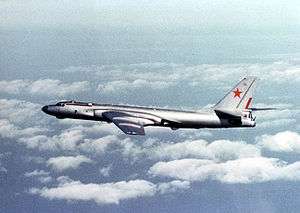
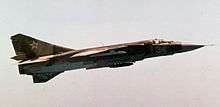
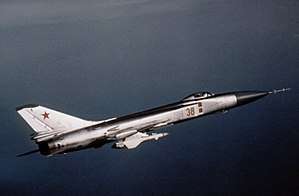
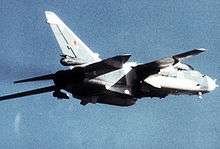
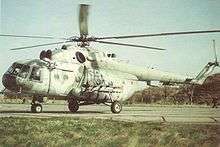
- 225 strategic bombers[53]
- 160 Tupolev Tu-95
- 35 Tupolev Tu-160
- 30 Myasishchev M-4
- 230 medium bombers[53]
- 120 Tupolev Tu-22M
- 80 Tupolev Tu-16
- 30 Tupolev Tu-22
- 1,904 fighters
- 326 Su-27 Flanker
- 185 MiG-21 Fishbed
- 40 MiG-25 Foxbat
- 700 MiG-23 Flogger
- 653 MiG-29 Fulcrum
- 2,135 attack aircraft[54]
- 500 MiG-27 Flogger-D
- 130 Su-7 Fitter-A
- 535 Su-17 Fitter
- 630 Su-24 Fencer
- 340 Su-25 Frogfoot
- 84 tankers
- 34 Il-76 Midas
- 30 M-4 'Molot' Bison
- 20 Tu-16 Badger
- 40 AWACS
- 40 Beriev A-50 Mainstay
- 1,015 Reconnaissance and ECM aircraft
- 50 MiG-21 Fishbed
- 170 MiG-25 Foxbat
- 190 Su-7R
- 235 Su-24 Fencer
- 200 Yak-28 Brewer
- 130 Tu-16 Badger
- 30 Tu-22M Backfire
- 10 Il-20 Coot
- 620 transport aircraft
- 45 An-124 'Ruslan' Condor
- 55 An-22 'Antey' Cock
- 210 An-12 Cub
- 310 Il-76 Candid
- 2,935 civilian and other transport aircraft, usually Aeroflot aircraft which were easily converted
See also
References
- ↑ Главное управление Военно-Воздушных сил Красной Армии [GUVVS] (in Russian), RU: RKKA .
- ↑ "The Command Structure of the Soviet Air Forces, 1918–1941". On Air power. 2008. Archived from the original on 27 July 2011. Retrieved 4 February 2011.
- ↑ Higham, Robin, and Greenwood, John T., Russian Aviation and Air Power in the Twentieth Century, Routledge Press (1998), ISBN 978-0-7146-4784-5, pp. 40–46.
- ↑ www.warintheskies.com, Mike Colclough,. "Soviet Air Force (VVS)". www.warintheskies.com. Retrieved 2017-02-05.
- ↑ Palmer, Scott (2006). Dictatorship of the Air: Aviation Culture and the Fate of Modern Russia. Cambridge, New York: Cambridge University Press. p. 220.
- ↑ Palmer, Dictatorship of the Air, 220.
- ↑ In 1935, attempts at navigating a transpolar route ended in failure. Palmer, Dictatorship of the Air, p.223.
- 1 2 Palmer, Dictatorship of the Air, p.230.
- ↑ As quoted in Bailes, Kendall (January 1976). "Technology and Legitimacy: Soviet Aviation and Stalinism in the 1930s". Technology and Culture. 17 (1): 63. doi:10.2307/3103253.
- ↑ Bergman, Jay (January 1998). "Valerii Chkalov: Soviet Pilot as New Soviet Man". Journal of Contemporary History. 33 (1): 136.
- ↑ Palmer, Dictatorship of the Air, 230
- ↑ Fitzpatrick, Sheila (1999). Everyday Stalinism: Ordinary Life in Extraordinary Times: Soviet Russia in the 1930s. New York: Oxford University Press. p. 73.
- ↑ Palmer, Scott (2005). "Icarus, East: The Symbolic Contexts of Russian Flight". The Slavic and East European Journal. 49 (1): 38. doi:10.2307/20058219.
- ↑ Palmer, Icarus, east, p.38
- 1 2 3 Palmer, Icarus, east, p.39
- 1 2 Bergman, p.149
- ↑ Palmer, Icarus, east, 39
- ↑ Bailes, pp.63–4
- ↑ Palmer, Dictatorship of the Air, p.248
- ↑ Bailes, p.64
- ↑ Hardesty, Von (1991) [1982]. "Where Was Our Air Force?". Red Phoenix: The Rise of Soviet Air Power 1941–1945. Washington, D.C.: Smithsonian Institution. p. 55. ISBN 0-87474-510-1.
- ↑ 2nd Air Army was created on 15 March 1937 in the Far East, and somewhat later 3rd Air Army was created in the North Caucasus Military District
- ↑ "Kharin", All Aces, RU .
- ↑ Bailes, p. 73
- ↑ Bailes, p. 69 quotes an article from Red Air Force General Alksnis: "The constructor who creates and equips the plane must be oriented not toward phenomenally gifted flyers but towards rank-and-file pilots."
- ↑ Bailes, p. 55
- ↑ Whiting, Kenneth (1986). Soviet Air Power (revised ed.). Boulder, Colorado: Westview Press. p. 125.
- ↑ "Why did Stalin rise to power?". Socialist Worker Online. 1 August 2003. Archived from the original on 10 January 2011. Retrieved 4 February 2011.
- ↑ Hardesty, Von (1991) [1982]. "Barbarossa to Berlin: A Summing Up". Red Phoenix: The Rise of Soviet Air Power 1941–1945. Washington, DC: Smithsonian Institution. p. 225. ISBN 0-87474-510-1.
- 1 2 Buckley, John (1999). Air Power in the Age of Total War. Indiana University Press. pp. 134, 143. ISBN 0-253-33557-4.
- ↑ Ratley III, Maj. Lonnie O (March–April 1983), "A Lesson of History: The Luftwaffe and Barbarossa", Air University Review, Maxwell US Air force base: Air & space power, archived from the original on 25 September 2014, retrieved 18 December 2015
- ↑ Michael Holm, 4th Guards Novgorodskiy Bomber Aviation Regiment. Retrieved August 2011
- ↑ Reagan, Geoffrey. Military Anecdotes (1992) p. 56, Guinness Publishing ISBN 0-85112-519-0
- ↑ Hardesty, Von (1991) [1982]. "At Full Stride". Red Phoenix: The Rise of Soviet Air Power 1941–1945. Washington, D.C.: Smithsonian Institution. p. 193. ISBN 0-87474-510-1.
- ↑ "1st Latvian Night Aviation Regiment (legkobombardirovochny rezhitsky)" (in Russian). AllAces.ru. Retrieved 4 February 2011.
- ↑ Wagner, Ray (ed.), and Leland Fetzer (trans.). The Soviet Air Force in World War II: The Official History. Melbourne: Wren Publishing, 1973, p.301. ISBN 0-85885-194-6.
- ↑ Hill, Alexander (2007). "British Lend Lease Aid and the Soviet War Effort, June 1941-June 1942". The Journal of Military History. 71 (3). JSTOR 30052890.
- ↑ Hardesty, Von (1991) [1982]. Red Phoenix: The Rise of Soviet Air Power 1941–1945. Washington, D.C.: Smithsonian Institution. p. 135. ISBN 0-87474-510-1.
- ↑ Red Phoenix, p. 253 (Appendixes)
- ↑ "Aviation History: Interview with World War II Soviet Ace Ivan Kozhedub". HistoryNet. 12 June 2006.
- ↑ Hames, David R. "Russian Aviation Regiments 1941–". UK: Samolet. Archived from the original on 16 March 2008.
- ↑ Holm, Michael, 1st Guards Fighter Aviation Division, DK: WW2, retrieved August 2011 Check date values in:
|accessdate=(help) . - ↑ "The U.S.S.R.: Moscow's Military Machine". Time. 23 June 1980. Retrieved 4 February 2011.
- ↑ Zaloga, Steve; Volstad, Ron (1987), Inside the Soviet army today, p. 9 .
- ↑ Odom, William E (2000), The Collapse of the Soviet Military, Yale University Press, pp. 45–46 notes that 97% of the officer corps was Russian, Ukrainian or Belorussian.
- ↑ Moynahan, Brian (1989), Claws of the Bear: The History of the Red Army from the Revolution to the Present, p. 337 .
- ↑ Wimbush, S. Enders; Alexiev, Alex (1982), The ethnic factor in the Soviet Armed Forces, RAND, p. vii .
- ↑ "First flight of fifth-generation fighter successful" (in Russian). RU: Lenta. 2011. Retrieved 4 February 2011.
- ↑ "Sukhoi Company launches flight tests of PAK FA advanced tactical frontline fighter". Sukhoi News. Sukhoi Company (JSC). 29 January 2011. Archived from the original on 1 May 2011. Retrieved 4 February 2011.
- ↑ Steven J. Zaloga, "Armed Forces in Ukraine", Jane's Intelligence Review, March 1992, p.135.
- ↑ Christina F. Shelton, "The Soviet Military Education System for Commissioning and Training Officers", a bibliographical description and a link to the document in PDF format, Appendix.
- ↑ Holm, Michael, Flying Schools and Training Centres, DK: WW2, retrieved August 2011 Check date values in:
|accessdate=(help) . - 1 2 "Russia: Long-range aviation". GlobalSecurity.org. 2010. Retrieved 4 February 2011.
- ↑ "Russia: Air forces inventory". GlobalSecurity.org. 2010. Retrieved 4 February 2011.
Further reading
- Andersson, Lennart. Soviet Aircraft and Aviation, 1917–1941. Annapolis, MD: Naval Institute Press, 1994. ISBN 1-55750-770-8.
- Bailes, Kendall (January 1976). "Technology and Legitimacy: Soviet Aviation and Stalinism in the 1930s". Technology and Culture 17 (1): 55–81.
- Bergman, Jay (January 1998). "Valerii Chkalov: Soviet Pilot as New Soviet Man". Journal of Contemporary History 33 (1): 136.
- Boyd, Alexander. The Soviet Air Force Since 1918. New York: Stein and Day, 1977. With section of black-and-white photographic plates, charts. maps and diagrams, together with index. First published in The Soviet Air Force by Macdonald and Janes (UK) in 1977.
- Loza, D. F. Attack of the Airacobras: Soviet Aces, American P-39s, and the Air War Against Germany. Lawrence, KS: University Press of Kansas, 2001. ISBN 0-7006-1140-1.
- Mason, Richard Anthony, and John William Ransom Taylor. Aircraft, strategy, and operations of the Soviet Air Force. London: Jane's, 1986.
- Palmer, Scott W. Dictatorship of the Air: Aviation Culture and the Fate of Modern Russia. New York: Cambridge University Press, 2006. ISBN 0-521-85957-3.
- Palmer, Scott (2005). "Icarus, East: The Symbolic Contexts of Russian Flight". The Slavic and East European Journal 49 (1): 38.
- Pennington, Reina. (2002) Wings, Women, and War: Soviet Airwomen in World War II Combat. Lawrence, KS: University Press of Kansas, 2002. ISBN 0-7006-1145-2.
- Von Hardesty; Ilya Grinberg (2012). Red Phoenix Rising: The Soviet Air Force in World War II (2nd ed.). University Press of Kansas. ISBN 978-0-7006-1828-6.
- Wagner, Ray (ed.), Fetzer, Leland, (trans.), The Soviet Air Force in World War II: The Official History, Wren Publishing, Melbourne, 1973 ISBN 0-85885-194-6
- Whiting, Kenneth (1986). Soviet Air Power (Revised Ed). Boulder, Colorado: Westview Press.
- "Советские Войска ПВО в последние годы Союза ССР. Часть 1" by A.G. Lenskiy and M.M. Tsybin, Saint Petersburg 2013, 164 pages
- "Все истребительные авиаполки Сталина" by V. Anokhin and M Bykhov, Moscow 2014, 944 pages
External links
- Dictatorship of the Air Website and blog devoted to Soviet/Russian aviation history
- Globalsecurity.org on Russian air arms, useful for structure of Soviet Air Force
| Wikimedia Commons has media related to Soviet Air Forces. |